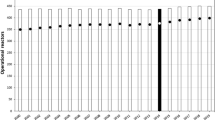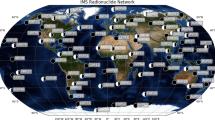Abstract
Monitoring of radioactive noble gases, in particular xenon isotopes, is a crucial element of the verification of the Comprehensive Nuclear-Test-Ban Treaty (CTBT). The capability of the noble gas network, which is currently under construction, to detect signals from a nuclear explosion critically depends on the background created by other sources. Therefore, the global distribution of these isotopes based on emissions and transport patterns needs to be understood. A significant xenon background exists in the reactor regions of North America, Europe and Asia. An emission inventory of the four relevant xenon isotopes has recently been created, which specifies source terms for each power plant. As the major emitters of xenon isotopes worldwide, a few medical radioisotope production facilities have been recently identified, in particular the facilities in Chalk River (Canada), Fleurus (Belgium), Pelindaba (South Africa) and Petten (Netherlands). Emissions from these sites are expected to exceed those of the other sources by orders of magnitude. In this study, emphasis is put on 133Xe, which is the most prevalent xenon isotope. First, based on the emissions known, the resulting 133Xe concentration levels at all noble gas stations of the final CTBT verification network were calculated and found to be consistent with observations. Second, it turned out that emissions from the radioisotope facilities can explain a number of observed peaks, meaning that atmospheric transport modelling is an important tool for the categorization of measurements. Third, it became evident that Nuclear Power Plant emissions are more difficult to treat in the models, since their temporal variation is high and not generally reported. Fourth, there are indications that the assumed annual emissions may be underestimated by factors of two to ten, while the general emission patterns seem to be well understood. Finally, it became evident that 133Xe sources mainly influence the sensitivity of the monitoring system in the mid-latitudes, where the network coverage is particularly good.











Similar content being viewed by others
References
Auer, M. et al. (2004), Intercomparison experiments of systems for the measurement of xenon radionuclides in the atmosphere, Appl. Radiat. Isot. 60(6), 863–877.
Becker, A. et al. (2007), Global backtracking of anthropogenic radionuclides by means of a receptor oriented ensemble dispersion modeling system in support of Nuclear-Test-Ban Treaty verification, Atmos. Environ. 41, 4520–4534.
Becker, A., Wotawa, G., Ringbom, A. and Saey, P.J.R. (2010), Backtracking of noble gas measurements taken in the aftermath of the announced October 2006 event in North Korea by means of PTS methods in nuclear source estimation and reconstruction, Pure Appl. Geophys. 167, 415, 2010, in press.
Bowyer, T.W., McIntyre, J.I., and Reeder, P. L. (1999), High-sensitivity detection of Xenon isotopes via beta-gamma coincidence counting, Abstract for the 21st Seismic Res. Symp., Technologies for Monitoring the Comprehensive Nuclear-Test-Ban Treaty, Las Vegas, USA, September 21–24.
CTBT (1996), Text of the Comprehensive Nuclear-Test-Ban Treaty. See Web Page of the United Nations Office for Disarmament Affairs (UNODA), Status of Multilateral Arms Regulation and Disarmament Agreements, CTBT (http://disarmament.un.org/TreatyStatus.nsf).
Currie, L.A. (1968), Limits for qualitative detection and quantitative determination. Application to radiochemistry, Analy. Chem. 40(3), 586–593.
De Geer, L.-E. Atmospheric radionuclide monitoring: A Swedish perspective, in Monitoring a Comprehensive Nuclear-Test-Ban Treaty, eds. E. S. Huseby and A. M. Dainty, pp. 157– 177 (Kluwer Acad., Dordrecht, Netherlands 1996).
Dubasov, Y.V., Popov, Y.S., Prelovskii, V.V., Donets, A.Y., Kazarinov, N.M., Mishurinskii, V. V., Popov, V.Y., Rykov, Y.M., and Skirda, N.V. (2005), The APИКC-01 Automatic Facility for Measuring Concentrations of Radioactive Xenon Isotopes in the Atmosphere, Instruments Experim. Techniques 48, 3, 373–379.
Fontaine, J. P., Pointurier, F., Blanchard, X., and Taffary, T. (2004), Atmospheric Xenon radioactive isotope monitoring, J. Environ. Radiat. 72, 129–135.
Hoffmann, W., Kebeasy, R., and Firbas, P. (2000), Introduction to the verification regime of the Comprehensive Nuclear-Test-Ban Treaty, Phys. Earth Planet. Inter. 113, 5–9.
Kalinowski, M.B., Becker, A., Saey, P.J.R., Tuma, M., and Wotawa, G. (2008), The complexity of CTBT verification. Taking noble gas monitoring as an example, Complexity 14, 1, 89–99.
Kalinowski, M. and Tuma, M. (2009), Global radioxenon emission inventory based on nuclear power reactor reports, J. Environ. Radioact. 100, 58–70.
Perkins, R. W., and Casey, L. A. (1996), Radioxenons: Their role in monitoring a Comprehensive Test-Ban Treaty, Rep. DOE/RL-96-1, Pac. Northwest Natl. Lab., Richland, Wash.
Riechmann, B. and Kalinowski, M. (2008), Implications of Xe emissions from medical isotope production, Geophys. Res. Abstracts, Vol. 10, EGU2008-A-07898.
Ringbom, A., Larson, T., Axelsson, A., Elmgren, K., and Johansson, C. (2003), SAUNA: A system for automatic sampling, processing and analysis of radioactive xenon, Nucl. Instrum. Methods, Phys. Res., Sect. A, 508, 542–553.
Ringbom, A., Elmgren, K. and Lindh, K. (2007), Analysis of radioxenon in ground level air sampled in the Republic of South Korea on October 11–14, 2006, FOI Report. FOI-R–2273—SE.
Saey, P. R. J., Wotawa, G., De Geer, L.-E., Axelsson, A., Bean, M., d’Amours, R., Elmgren, K., Peterson, J., Ringbom, A., Stocki, T. J., and Ungar, R. K. (2006), Radioxenon background at high northern latitudes, J. Geophys. Res. 111, D17306, doi:10.1029/2005JD007038.
Saey, P. R. J., Bean, M., Becker, A., Coyne, J., d’Amours, R., De Geer, L.-E., Hogue, R., Stocki, T. J., Ungar, R. K., and Wotawa, G. (2007), A long distance measurement of radioxenon in Yellowknife, Canada, in late October 2006, Geophys. Res. Lett. 34, L20802, doi:10.1029/2007GL030611.
Saey, P.R.J. (2009): The influence of radiopharmaceutical isotope production on the global radioxenon background, J. Environm. Radioact. doi:10.1016/j.jenvrad.2009.01.004, in press.
Saey, P.R.J. and De Geer, L.-E. (2005), Notes on radioxenon measurements for CTBT verification purposes, Appl. Radiat. Isot. 63, 765–773.
Schulze, J., Auer, M., and Werzi, R. (2000), Low level radioactivity measurement in support of the CTBTO, Appl. Radiat. Isot. 53, 23–30.
Stocki, T.J., Blanchard, X., D’Amours, R., Ungar, R.K., Fontaine, J.P., Sohier, M., Bean, M., Taffary, T., Racine, J., Tracy, B.L., Brachet, G. Jean, M., and Meyerhof, D. (2005), Automated radioxenon monitoring for the Comprehensive Nuclear-Test-Ban Treaty in two distinct locations: Ottawa and Tahiti, J. Environm. Radioact. 80, 305–326.
Stohl, A., Forster, C., Frank, A., Seibert, P., and Wotawa, G. (2005), Technical note: The Lagrangian particle dispersion model FLEXPART version 6.2, Atmos. Chem. Phys. 5, 2461–2474.
Wernsberger, B. and Schlosser, C. (2004), Noble gas monitoring within the international monitoring system of the Comprehensive Nuclear Test-Ban Treaty, Radiation Phys. Chem. 71, 775–779.
Wotawa, G. et al. (2003), Atmospheric transport modelling in support of CTBT verification: Overview and basic concepts, Atmos. Environ. 37(18), 2529–2537.
Wotawa, G., De Geer, L.-E., Becker, A., D’Amours, R., Jean, M., Servranckx, R., and Ungar, K. (2006), Inter- and intra-continental transport of radioactive cesium released by boreal forest fires, Geophys. Res. Lett. 33, L12806, doi:10.1029/2006GL026206.
Author information
Authors and Affiliations
Corresponding author
Rights and permissions
About this article
Cite this article
Wotawa, G., Becker, A., Kalinowski, M. et al. Computation and Analysis of the Global Distribution of the Radioxenon Isotope 133Xe based on Emissions from Nuclear Power Plants and Radioisotope Production Facilities and its Relevance for the Verification of the Nuclear-Test-Ban Treaty. Pure Appl. Geophys. 167, 541–557 (2010). https://doi.org/10.1007/s00024-009-0033-0
Received:
Revised:
Accepted:
Published:
Issue Date:
DOI: https://doi.org/10.1007/s00024-009-0033-0




